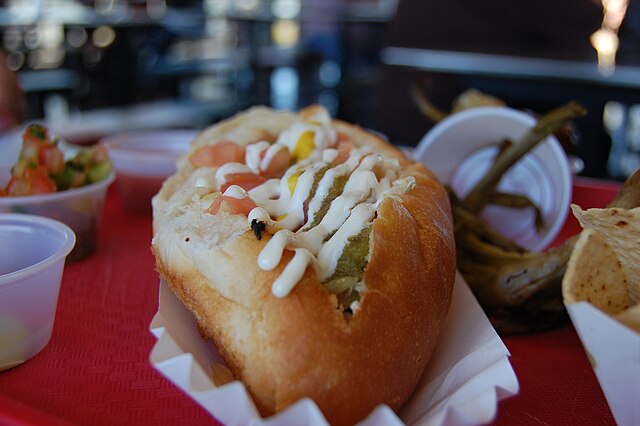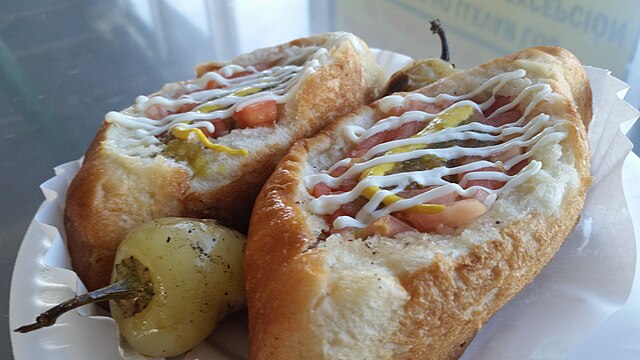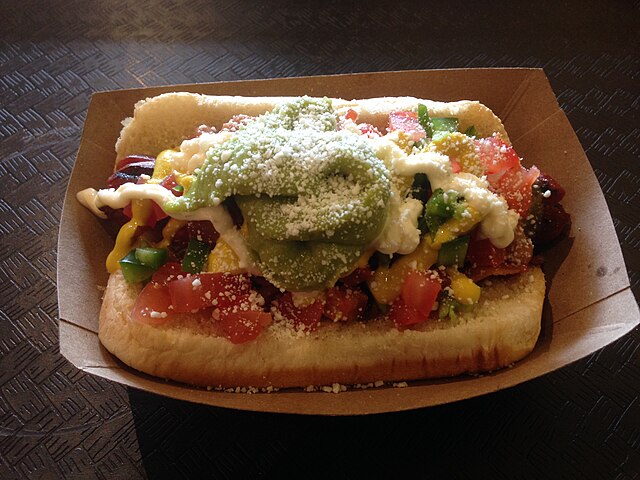Have you ever wondered what happens when Mexican creativity meets American street food? The answer lies in the smoky, bacon-wrapped perfection of Sonoran hot dogs. This isn’t just another hot dog – it’s a culinary masterpiece that’s been turning heads and satisfying cravings across Arizona for decades.
Picture this: a juicy hot dog wrapped in crispy bacon, nestled in a soft bolillo roll, and topped with an orchestra of fresh ingredients. It’s comfort food that tells a story, bridging cultures and creating something entirely unique. Whether you’re a longtime Arizona resident or planning your first visit to the Southwest, understanding Sonoran hot dogs is like getting a taste of the region’s soul.
What Makes Sonoran Hot Dogs So Special?
The magic of Sonoran hot dogs isn’t just in their taste – though trust me, one bite and you’ll understand the obsession. It’s in their ability to represent the beautiful fusion of Mexican and American food cultures. These aren’t your ballpark franks; they’re sophisticated street food that deserves serious respect.
The Birth of a Culinary Icon
The story begins in Hermosillo, Sonora, Mexico, where creative street vendors started wrapping hot dogs in bacon sometime in the 1980s. Think of it as culinary evolution in action – taking something familiar and making it extraordinary. When this concept crossed the border into Arizona, it found the perfect home.
Arizona’s large Mexican-American population embraced these bacon-wrapped beauties, and they quickly became more than just street food. They became a symbol of cultural identity, representing the seamless blend of traditions that defines much of the Southwest. Today, you’ll find Sonoran hot dog carts on countless street corners, their smoky aromas drawing crowds like a delicious siren song.
Why Bacon Changes Everything
Let’s be honest – bacon makes everything better. But in Sonoran hot dogs, it’s not just an add-on; it’s integral to the experience. The bacon doesn’t just add flavor; it creates texture, provides fat that keeps the hot dog moist, and forms a crispy shell that contrasts beautifully with the soft bun and fresh toppings.
When you bite into a properly made Sonoran hot dog, you get that satisfying bacon crunch followed by the juicy hot dog, all enhanced by the fresh vegetables and creamy sauces. It’s a symphony of textures and flavors that regular hot dogs simply can’t match.
The Anatomy of an Authentic Sonoran Hot Dog

Creating an authentic Sonoran hot dog is like conducting an orchestra – every element must work in harmony. Miss one component, and the whole experience falls flat. Let’s break down what makes these dogs truly special.
Essential Ingredients You Can’t Skip
Authenticity matters when it comes to Sonoran hot dogs. While creative variations exist, certain elements are non-negotiable if you want the real deal.
The Perfect Hot Dog
Not all hot dogs are created equal, and Sonoran hot dogs demand quality. Traditional versions use all-beef hot dogs with natural casings that provide that satisfying snap when you bite down. The hot dog should be flavorful enough to hold its own against the bacon and toppings without being overpowering.
Many authentic vendors prefer Mexican-style hot dogs, which tend to be a bit spicier and more seasoned than typical American varieties. These dogs have more character and complement the other ingredients better than bland, mass-produced alternatives.
Bacon: The Star of the Show
The bacon isn’t just wrapped around the hot dog – it’s carefully spiraled to ensure even coverage and consistent cooking. Quality matters here too. You want bacon that’s thick enough to stay crispy but not so thick that it overwhelms the hot dog. The bacon should render properly, creating that golden, crispy exterior that defines a great Sonoran hot dog.
Traditional Toppings That Matter
Here’s where Sonoran hot dogs really shine – the toppings aren’t afterthoughts; they’re carefully chosen components that create balance:
- Pinto beans: Usually whole, these add protein and earthiness
- Diced tomatoes: Fresh, never canned, providing acidity and freshness
- White onions: Raw and diced fine, adding sharp bite
- Mexican crema or mayonnaise: The creamy element that ties everything together
- Avocado or guacamole: Rich, creamy, and essential for authenticity
- Jalapeños: Pickled or fresh, providing heat and tang
- Mexican salsa verde: The acidic component that brightens the whole dish
The Art of Assembly
Building a Sonoran hot dog is an art form. The bolillo roll is lightly toasted, the bacon-wrapped hot dog is grilled to perfection, and then comes the careful layering of toppings. It’s not just thrown together – there’s a method that ensures every bite contains the perfect ratio of ingredients.
The beans go on first, creating a bed for the hot dog. Then comes the hot dog itself, followed by the fresh vegetables, and finally the sauces. Some vendors have their own signature assembly style, but the goal is always the same: a perfectly balanced bite every time.
Where to Find the Best Sonoran Hot Dogs
Arizona is ground zero for Sonoran hot dogs in the United States, and both Phoenix and Tucson have developed their own vibrant scenes. Finding great Sonoran hot dogs isn’t hard – finding the absolute best requires some insider knowledge.
Top Phoenix Locations
Phoenix’s Sonoran hot dog scene is thriving, with options ranging from traditional street carts to upscale restaurants putting their own spin on the classic. The key is knowing where the locals go.
Street carts remain the most authentic experience. You’ll find them in areas with large Mexican-American populations, often operating in the evenings and weekends. These carts typically offer the most traditional preparation methods and have perfected their recipes over years of serving the community.
For those who prefer a restaurant setting, several Phoenix establishments have built reputations on their Sonoran hot dogs. These places often offer expanded menus while maintaining authenticity in their core offering.
Tucson’s Hidden Gems
Tucson, being closer to the Mexican border, claims to have the most authentic Sonoran hot dog scene in Arizona. The competition here is fierce, which means consistently high quality across numerous vendors.
El Güero Canelo: The Original
No discussion of Sonoran hot dogs is complete without mentioning El Güero Canelo. This Tucson institution has been serving authentic Sonoran hot dogs since the 1990s and is often credited with popularizing them in Arizona. Their preparation is textbook perfect, and they’ve maintained quality while expanding to multiple locations.
BK Tacos: Local Favorite
While perhaps less famous than El Güero Canelo, BK Tacos has developed a devoted following for their take on Sonoran hot dogs. They’ve mastered the balance of traditional preparation with just enough personal flair to make their version memorable.
Making Sonoran Hot Dogs at Home

Creating authentic Sonoran hot dogs at home is easier than you might think, but it does require attention to detail and quality ingredients. The good news? Once you master the technique, you’ll never want regular hot dogs again.
Shopping for Ingredients
Success starts with shopping smart. Your regular grocery store might not have everything you need, so be prepared to visit a Mexican market for some ingredients. The extra effort pays off in authenticity and flavor.
For the hot dogs, look for all-beef varieties with natural casings. Mexican brands are ideal, but high-quality American brands work too. Avoid the cheapest options – they won’t provide the flavor foundation your Sonoran hot dogs need.
The bacon should be thick-cut but not so thick that it won’t cook properly when wrapped around the hot dog. You want enough fat content to render properly but not so much that it becomes greasy.
Step-by-Step Cooking Guide
Making Sonoran hot dogs at home requires patience and attention to detail, but the results are worth every minute.
Prep Work Tips
Start by wrapping each hot dog tightly with bacon, spiraling from one end to the other. Secure with toothpicks if needed, but remove them before serving. The wrap should be tight enough to stay put but not so tight that it restricts the hot dog.
Prepare all your toppings before you start cooking. Dice the tomatoes and onions finely, warm the beans, and have your sauces ready. Sonoran hot dogs are best served immediately after cooking, so preparation is key.
Cooking Techniques
The traditional method involves grilling on a flat-top grill or comal, but a cast-iron skillet works well at home. Cook the bacon-wrapped hot dogs slowly, turning frequently to ensure even browning. The bacon should be crispy all around, and the hot dog should be heated through.
Don’t rush this step – proper cooking is what separates good Sonoran hot dogs from great ones. The bacon needs time to render and crisp up, while the hot dog heats evenly throughout.
The Cultural Impact of Sonoran Hot Dogs
Sonoran hot dogs represent more than just food – they’re a symbol of cultural fusion and the Mexican-American experience in the Southwest. Understanding their cultural significance helps explain why they’ve become so much more than just another street food.
From Street Food to Mainstream
The journey of Sonoran hot dogs from humble street carts to mainstream recognition mirrors the broader story of Mexican-American cuisine in the United States. What started as immigrant comfort food has become a celebrated regional specialty that attracts food tourists from around the world.
This evolution speaks to the power of authentic flavors and the growing appreciation for diverse culinary traditions. Sonoran hot dogs prove that great food transcends cultural boundaries and that innovation often comes from the fusion of different traditions.
Social Media and Food Tourism
Instagram and food blogs have played a huge role in spreading awareness of Sonoran hot dogs beyond Arizona. Their photogenic nature – with that beautiful bacon spiral and colorful toppings – makes them perfect for social media sharing.
This exposure has led to increased food tourism in Arizona, with visitors specifically seeking out the best Sonoran hot dogs. Food tours now include stops at famous vendors, and the dish has become as much a part of Arizona’s identity as cacti and sunsets.
Health Considerations and Alternatives

Let’s address the elephant in the room – Sonoran hot dogs aren’t health food. But understanding their nutritional profile and exploring healthier alternatives can help you enjoy them responsibly.
Nutritional Breakdown
A typical Sonoran hot dog contains significant calories, primarily from the hot dog, bacon, and creamy toppings. The beans and vegetables do provide some nutritional value, including protein, fiber, and vitamins, but they’re outweighed by the processed meat and fat content.
However, context matters. Enjoyed occasionally as part of a balanced diet, Sonoran hot dogs can be a reasonable indulgence. The key is moderation and being mindful of what else you’re eating throughout the day.
Healthier Variations
Creative home cooks have developed lighter versions that maintain the spirit of Sonoran hot dogs while reducing calories and improving nutrition. Turkey or chicken sausages can replace traditional hot dogs, while turkey bacon offers a leaner alternative to pork bacon.
Some versions incorporate more vegetables and reduce the amount of high-calorie toppings without sacrificing flavor. While these alternatives might not be traditional, they allow health-conscious eaters to enjoy the flavors they love.
Conclusion
Sonoran hot dogs represent the beautiful complexity of American regional cuisine. They’re a testament to the creativity that emerges when cultures meet and blend, creating something entirely new yet deeply rooted in tradition. From their humble beginnings on the streets of Hermosillo to their current status as Arizona’s unofficial state food, these bacon-wrapped beauties have earned their place in the pantheon of great American street food.
Whether you’re planning a trip to Arizona to experience the authentic versions or getting ready to try making them at home, remember that Sonoran hot dogs are more than just food – they’re a cultural experience. Each bite tells the story of innovation, tradition, and the delicious possibilities that emerge when good ideas cross borders.
The next time you’re in Phoenix or Tucson, seek out a street cart or authentic restaurant and experience these amazing hot dogs for yourself. And if you can’t make it to Arizona, don’t despair – with the right ingredients and techniques, you can bring a taste of this Southwest tradition to your own kitchen.
Frequently Asked Questions
1. What’s the difference between a regular hot dog and a Sonoran hot dog?
The main difference is that Sonoran hot dogs are wrapped in bacon before cooking and served with specific toppings like pinto beans, diced tomatoes, onions, avocado, and Mexican crema on a bolillo roll. Regular hot dogs typically use standard buns and simpler toppings like mustard and ketchup.
2. Can I make Sonoran hot dogs without a grill?
Absolutely! You can make excellent Sonoran hot dogs using a cast-iron skillet, regular frying pan, or even bake them in the oven. The key is ensuring the bacon gets crispy all around while the hot dog heats through completely.
3. Where did Sonoran hot dogs originally come from?
Sonoran hot dogs originated in Hermosillo, Sonora, Mexico, in the 1980s. Street vendors began wrapping hot dogs in bacon and adding traditional Mexican toppings, creating this unique fusion dish that later became popular in Arizona.
4. Are there vegetarian versions of Sonoran hot dogs?
Yes! Many people make vegetarian versions using plant-based hot dogs and either vegetarian bacon or skipping the bacon entirely while keeping all the traditional toppings. While not traditional, these versions can still be delicious and capture the essence of the dish.
5. What type of roll is traditionally used for Sonoran hot dogs?
Traditional Sonoran hot dogs use bolillo rolls, which are crusty Mexican bread rolls similar to French bread but smaller. If you can’t find bolillos, a good substitute is a crusty hot dog bun or small French bread roll, lightly toasted before assembly.

